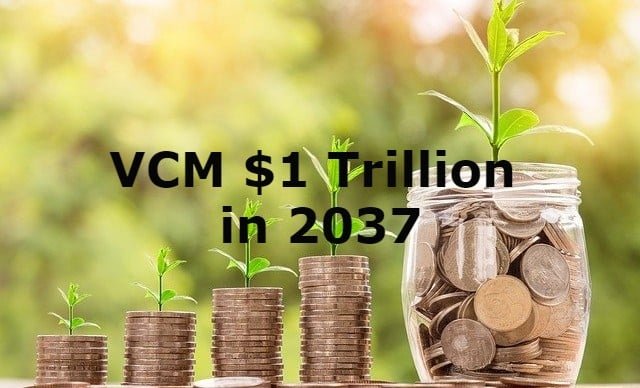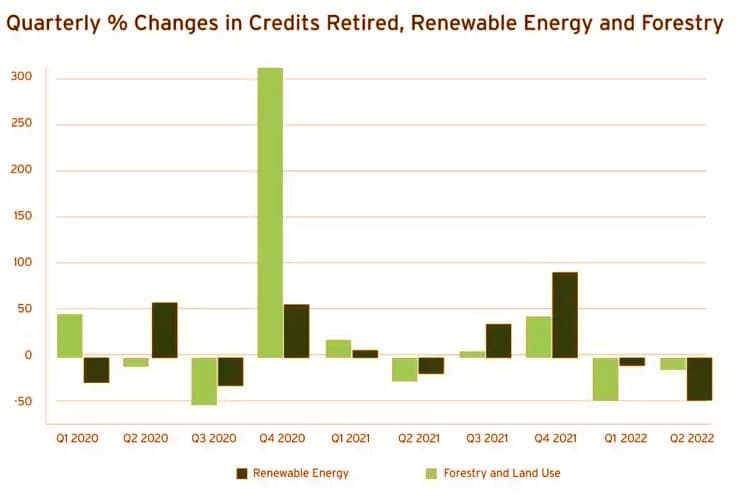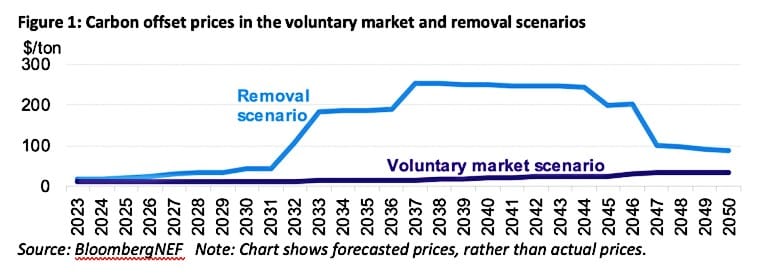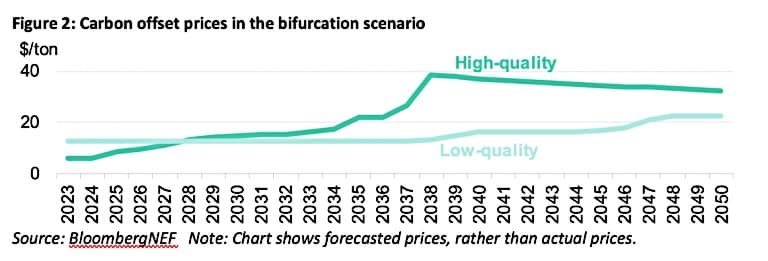The total value of carbon credits traded in the market to help entities achieve their net zero goals can be worth $1 trillion as early as 2037, according to a recent report by BloombergNEF.
Verified emission reduction credits or carbon credits are traded in the voluntary carbon market (VCM), equivalent to 1 ton of carbon reduced or removed. Under its current structure, the VCM is “not built for success”, BloombergNEF said. But the research provider also noted that:
“More rigorous definitions of quality and greater emphasis on carbon removal could solidify market confidence, lift prices and drive demand.”
The VCM Growth (2021 – 2022)
Investments in VCM projects grew to $10 billion in 2022, up from $7 billion in 2021, a new report has found. Yet the market failed to grow last year as BNEF reported in its Long-Term Carbon Offsets Outlook.
- Firms bought only 155 million carbon credits as offsets, down 4% from 2021. The major reason being is the fear of reputational risk from buying low-quality credits.
But carbon credits supply jumped by 2%, with a total of 255 million carbon offsets generated globally. Remarkably, the supply of credits from “avoided deforestation” fell by a third from 2021 to 2022.
There were accusations of greenwashing in buying carbon credits from nature-based projects that had questionable environmental impact. REDD+ projects, in particular, are still under criticism after analysis claiming they produce “ghost credits”.
In a different market analysis by AlliedOffsets, the lack of growth in the VCM is due to a slowdown in retirements of carbon credits. 2022 has seen slowing growth in retirements after last year’s explosion as seen in the chart below.
Voluntary Carbon Credits Retirement
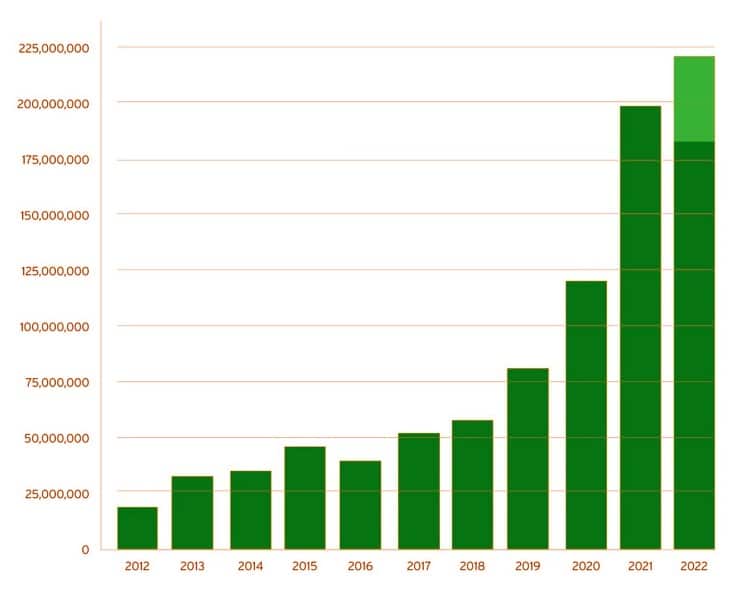
In particular, retirements of renewable energy and forestry credits declined in two consecutive quarters as shown below. This is the first time that it has happened in VCM history.
BNEF VCM Projections Under 3 Scenarios
-
The Voluntary Credit Market Scenario
The BNEF modeled supply, demand, and prices for carbon offset credits under three different scenarios by 2050. Under each scenario, demand grows at various rates, and so do the prices.
In the first scenario, entities can buy any type of carbon credits to meet their decarbonization goals. In this case, they’ll need about 5.4 billion credits each year in 2050. There’s oversupply of credits and 8 billion of them will be produced annually, mostly from avoided deforestation.
As shown in the graph above, carbon prices in the VCM scenario will go up to only $12/ton in 2030 and $35/ton in 2050. The total market value would only be $15 billion each year in 2030. Still, that’s a 650% increase from the $2 billion valuation in 2022.
2. The Removal Scenario
Under this second scenario, carbon credits from projects that actually remove carbon from the air only count. Those from avoided deforestation or clean energy projects are not part of the supply.
As such, supplies will be short in 2037 as carbon removal technologies, e.g. direct air capture (DAC), are still expensive to scale up. Carbon prices for removals are far way higher than in the VCM scenario at ~ $250/ton. Annual market value will be as high as $1 trillion.
But as DAC and other carbon removal tech receive more investments, costs will go down below $100/ton by 2050.
Yet, high prices may prompt some firms to put their money in other net zero strategies over carbon offsetting. Or worse, it may force them to neglect their climate goals entirely if carbon removal credits remain too costly for them to offset emissions.
3. The Bifurcation (Two Market Branches) Scenario
The debate on what makes a carbon credit high-quality continues to this day. Stakeholders – investors, companies, and non-profits – believe that defining quality involves a set of criteria. The major ones include additionality, permanence, and co-benefits (benefits apart from reducing emissions).
- In effect, the third BNEF’s scenario emerges from this debate – the bifurcation or splitting of the market into two branches.
In a smaller branch lies the less liquid market for high-quality carbon credits. These include credits from carbon removal technology projects and nature-based solutions in Oceania, Africa, and North America.
Demand for high-quality carbon credits peaks at 433 million only in 2030 and 1.3 billion in 2050. And buyers will also have a smaller supply compared to other scenarios, at 1.4 billion and 3.2 billion in the same periods. Carbon prices reach $38/ton in 2039 before falling to $32/ton in 2050.
In another branch is the larger market for low-quality credits from energy generation and nature-based solutions in Latin America and Asia. Prices will be at only $12/ton in 2025 and peak at only $22/ton in 2050.
- Entities relying in this market for offsetting their emissions may have to deal with greater reputational risks.
Overall, the outcomes of this third market scenario may change depending on what constitutes low- and high-quality offset credits. What will help clarify quality tiers are simplifying and standardizing carbon credit buying.
Standardization in Carbon Credits Market
Standardization can drive more market liquidity and help stakeholders better decide on their offsetting strategies. Carbon exchanges, technology providers, and private sector initiatives are working hard to achieve this.
But buyers may become more confused if many groups are addressing the issue separately.
Kyle Harrison, Head of Sustainability Research at BNEF and the report’s lead author remarked:
“Buyers need transparency, clear definitions around quality and easy access to premium supply, or future years will resemble what we saw in 2022. These changes will send demand signals to the projects making the greatest decarbonization impact and in need of the most investment.”
He further added that standardization is the carbon credit market’s space race. Only by resolving this matter can the carbon market grow by several orders of magnitude.

